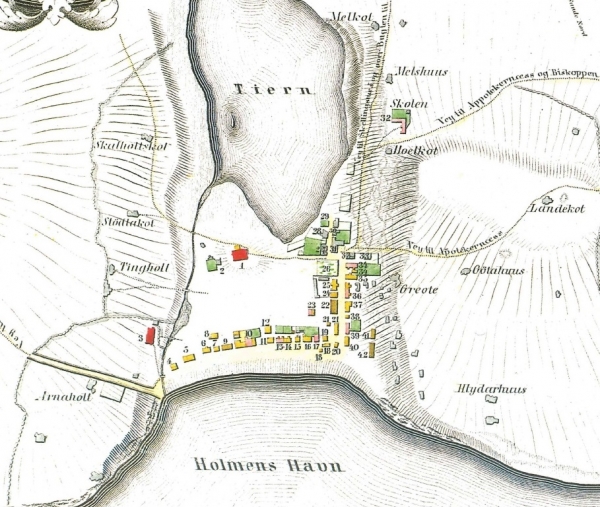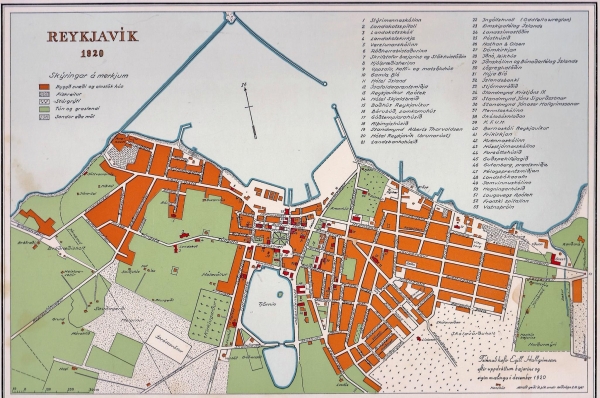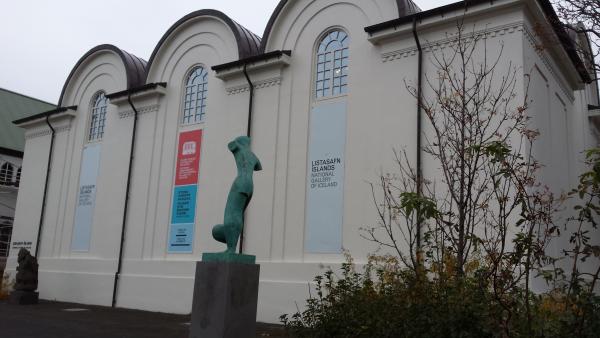Located in the heart of the city the downtown pond Tjörnin is one of the defining landmarks of downtown Reykjavík. It's bird life and the beautiful colorful homes lining its banks make it a wonderful destination for a lazy afteron stroll.
1. Its really a pond rather than a lake
Despite being sometimes referred to as the downtown lake, Tjörnin hardly qualifies as a lake. While there is no precise scientific definition of what constitutes as a lake or a pond, Icelanders have always viewed Tjörnin as a pond rather than a lake: The name Tjörnin literally translates as The Pond.
However, it has also been described as a shallow lake in Icelandic books about Reykjavík. And it is very shallow: The average depth of Tjörnin is just 57 cm (1.9 feet). The deepest parts of the northern part of Tjörnin is just 80 cm (2.4 feet).
2. But startet its life as a lagoon

However, Tjörnin should probably be seen as a lagoon. Before the settlement of Iceland and the growth of Reykjavík the pond was much larger, extending further to the north.
It is connected to the ocean via a river, Lækurinn, which currently runs in a sewer beneath Lækjargata street. At high tide the ocean would flow into Tjörnin, which makes it into a lagoon.
Downtown Reykjavík is built on a narrow sand and gravel barrier which seperates the ocean and the pond. At the time of the settlement of Iceland the pond extended much further to the north, and the ocean much further south, while the river connecting Tjörnin and the ocean was more of a channel than a river, the direction of the current determined by the tides.
Since then the river has been covered and downtown has expanded with landfills in both directions, chipping away at Tjörnin. After the river Lækurinn was moved into a sewer Tjörnin also no longer feels the tides.
3. It's really a chain of ponds capped with wetlands

All in all Tjörnin is composed of five separate ponds and the wetland preserve Vatnsmýrin. The main body of water, which covers 8.7 hectares is cut in two by Skothúsvegur street in 1920. The northern part, usually referred to as Tjörnin is considered a distinct pond from Suðurtjörnin, The Southern Pond, which is surrounded by a public park, Hljómskálagarðurinn.
A smaller pond, Þorfinnstjörn, the Pond of Þorfinnur, is located in Hljómskálagarður park. This pond is actually man-made, as the park used to be part of the Vatnsmýri wetlands to the south of Tjörnin.
The entire park used to be wetlands with shallow ponds, but in the early 20th century the moor was filled up, creating a park and recreational area for the small town. In 1923 a small pond with a nesting island for ducks was added to the park.
The three ponds and public park are separated from the remaining patch of the wetlands, Vatnsmýrin by one of the main traffic arteries of Reykjavík, Hringbrautin street. Two additional ponds are located in the wetland, Vatnsmýrartjörn and Hústjörn in front of the Nordic House culture center.
4. Hot water is used to keep a small corner ice free in the winter
The pond is a popular destination for local families both in winter and summer. In the summer people stroll around the pond and parents take their children to the pond to feed the ducks and geese bread.

During winter the pond freezes over, making it a popular spot for ice skating, the Reykjavík ice skating association having been founded on the pond in 1892. Students from the two downtown junior colleges also use the ice to play football.
Read more: Heating soccer fields and growing cucumbers: 9 ways in which geothermal energy is used in Iceland
However, no matter how cold it gets a small part of the lake in its NE-corner remains ice-free. This is because the city uses hot water to maintain the temperature of the water here above freezing, thus ensuring the birds have at least a small piece of open water.
Five duck species nest each year at the pond, in addition to at least two other irregular guests. The five permanent residents are mallards, which are the most populous, gadwall, greater scaup, tufted ducks and teal. Red-breasted mergansers and Eurasian wigeons have been regular guests, although they don't nest every year.
Read more: Reykjavík's downtown Lake Tjörnin (The Pond) is teeming with life
In addition to the ducks a significant population of greylag geese and eider nests at the pond. The ducks, geese and eider primarily nest in the small islands, while a large population of Artic tern nest in the Vatnsmýrin wetland preserve.
Four species of wetland birds also nest in Vatnsmýrinin, the common snipe, ringed plovers, redshanks and Eurasian oystercatchers.
The pond also has a large population of swans, but these are mostly birds who nest elsewhere, but spend the winter at the pond, taking advantage of the open water and the bread local children bring to feed the birds!
6. Ducks and geese were hunted by the lake until 1919

Throughout the centuries locals have hunted geese and ducks at the pond and in the nearby wetlands. In 1919, however, all hunting was banned. Since then the bird population has increased, with more species nesting at the pond.
Instead of hunting the birds humans now spend considerable effort to protect them. The city exterminator removes the eggs of seagulls and destroys the nests of seagulls who attempt to settle at the pond, since seagulls pray on smaller birds and their nests.
Read more: Record number of Arctic Terns by the downtown lake provide protection for ducklings
Unfortunately this does not stop seagulls who nest in the islands off the coast of Reykjavík from launching raids on the birds of Tjörnin. Fortunately the Arctic tern protects its nesting grounds with such fierceness that it keeps the seagulls away, thus providing the ducks with effective air defenses!
7. Prior to refrigiration Tjörnin was used to harvest ice

Prior to the widespread use of refrigeration the pond was used to harvest ice. In the early 20th century warehouses were built by the pond to house the ice, which was used by fishermen to keep their catch fresh.
One of these, built in 1916 still stands on the eastern shore of the pond. This building, designed by Guðjón Samúelsson, the same architect who later designed Reykjavík's best known landmark Hallgrímskirkja church, currently houses the Icelandic National Art Museum.
Located in the heart of the city the downtown pond Tjörnin is one of the defining landmarks of downtown Reykjavík. It's bird life and the beautiful colorful homes lining its banks make it a wonderful destination for a lazy afteron stroll.
1. Its really a pond rather than a lake
Despite being sometimes referred to as the downtown lake, Tjörnin hardly qualifies as a lake. While there is no precise scientific definition of what constitutes as a lake or a pond, Icelanders have always viewed Tjörnin as a pond rather than a lake: The name Tjörnin literally translates as The Pond.
However, it has also been described as a shallow lake in Icelandic books about Reykjavík. And it is very shallow: The average depth of Tjörnin is just 57 cm (1.9 feet). The deepest parts of the northern part of Tjörnin is just 80 cm (2.4 feet).
2. But startet its life as a lagoon

However, Tjörnin should probably be seen as a lagoon. Before the settlement of Iceland and the growth of Reykjavík the pond was much larger, extending further to the north.
It is connected to the ocean via a river, Lækurinn, which currently runs in a sewer beneath Lækjargata street. At high tide the ocean would flow into Tjörnin, which makes it into a lagoon.
Downtown Reykjavík is built on a narrow sand and gravel barrier which seperates the ocean and the pond. At the time of the settlement of Iceland the pond extended much further to the north, and the ocean much further south, while the river connecting Tjörnin and the ocean was more of a channel than a river, the direction of the current determined by the tides.
Since then the river has been covered and downtown has expanded with landfills in both directions, chipping away at Tjörnin. After the river Lækurinn was moved into a sewer Tjörnin also no longer feels the tides.
3. It's really a chain of ponds capped with wetlands

All in all Tjörnin is composed of five separate ponds and the wetland preserve Vatnsmýrin. The main body of water, which covers 8.7 hectares is cut in two by Skothúsvegur street in 1920. The northern part, usually referred to as Tjörnin is considered a distinct pond from Suðurtjörnin, The Southern Pond, which is surrounded by a public park, Hljómskálagarðurinn.
A smaller pond, Þorfinnstjörn, the Pond of Þorfinnur, is located in Hljómskálagarður park. This pond is actually man-made, as the park used to be part of the Vatnsmýri wetlands to the south of Tjörnin.
The entire park used to be wetlands with shallow ponds, but in the early 20th century the moor was filled up, creating a park and recreational area for the small town. In 1923 a small pond with a nesting island for ducks was added to the park.
The three ponds and public park are separated from the remaining patch of the wetlands, Vatnsmýrin by one of the main traffic arteries of Reykjavík, Hringbrautin street. Two additional ponds are located in the wetland, Vatnsmýrartjörn and Hústjörn in front of the Nordic House culture center.
4. Hot water is used to keep a small corner ice free in the winter
The pond is a popular destination for local families both in winter and summer. In the summer people stroll around the pond and parents take their children to the pond to feed the ducks and geese bread.

During winter the pond freezes over, making it a popular spot for ice skating, the Reykjavík ice skating association having been founded on the pond in 1892. Students from the two downtown junior colleges also use the ice to play football.
Read more: Heating soccer fields and growing cucumbers: 9 ways in which geothermal energy is used in Iceland
However, no matter how cold it gets a small part of the lake in its NE-corner remains ice-free. This is because the city uses hot water to maintain the temperature of the water here above freezing, thus ensuring the birds have at least a small piece of open water.
Five duck species nest each year at the pond, in addition to at least two other irregular guests. The five permanent residents are mallards, which are the most populous, gadwall, greater scaup, tufted ducks and teal. Red-breasted mergansers and Eurasian wigeons have been regular guests, although they don't nest every year.
Read more: Reykjavík's downtown Lake Tjörnin (The Pond) is teeming with life
In addition to the ducks a significant population of greylag geese and eider nests at the pond. The ducks, geese and eider primarily nest in the small islands, while a large population of Artic tern nest in the Vatnsmýrin wetland preserve.
Four species of wetland birds also nest in Vatnsmýrinin, the common snipe, ringed plovers, redshanks and Eurasian oystercatchers.
The pond also has a large population of swans, but these are mostly birds who nest elsewhere, but spend the winter at the pond, taking advantage of the open water and the bread local children bring to feed the birds!
6. Ducks and geese were hunted by the lake until 1919

Throughout the centuries locals have hunted geese and ducks at the pond and in the nearby wetlands. In 1919, however, all hunting was banned. Since then the bird population has increased, with more species nesting at the pond.
Instead of hunting the birds humans now spend considerable effort to protect them. The city exterminator removes the eggs of seagulls and destroys the nests of seagulls who attempt to settle at the pond, since seagulls pray on smaller birds and their nests.
Read more: Record number of Arctic Terns by the downtown lake provide protection for ducklings
Unfortunately this does not stop seagulls who nest in the islands off the coast of Reykjavík from launching raids on the birds of Tjörnin. Fortunately the Arctic tern protects its nesting grounds with such fierceness that it keeps the seagulls away, thus providing the ducks with effective air defenses!
7. Prior to refrigiration Tjörnin was used to harvest ice

Prior to the widespread use of refrigeration the pond was used to harvest ice. In the early 20th century warehouses were built by the pond to house the ice, which was used by fishermen to keep their catch fresh.
One of these, built in 1916 still stands on the eastern shore of the pond. This building, designed by Guðjón Samúelsson, the same architect who later designed Reykjavík's best known landmark Hallgrímskirkja church, currently houses the Icelandic National Art Museum.







